10.09.16
Posted in America, Patents at 6:12 pm by Dr. Roy Schestowitz
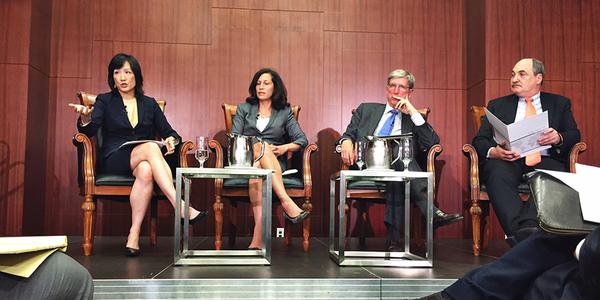
Summary: Texas and its epidemic of patent trolls (owing to trolls-friendly courts) may be enjoying its last months of exploitation and the patent law firms that are based there might soon need to relocate
THE USPTO is moving in the opposite direction of the EPO (which pursues the UPC). Tomorrow we’ll publish a lengthy and detailed post about the FTC study, but today — in preparation for that — we shall remark on another aspect.
A recent article by Annalee Newitz spoke about Lee Cheng, who made a name for himself by fighting patent trolls to death and even compelling them to pay Newegg’s legal fees after the trolls had lost (a lengthy and expensive process). Newegg was praised here in the past for this (one example among half a dozen from last year) and ““Patents are bullshit,” says Newegg legal chief” is the headline of this new article. To quote from it:
Lee Cheng is one of the few attorneys to fight back against patent trolls and prevail. And at the latest Ars Live event, we talked to him about his most famous case, how people can fight patent trolls today, and what the future of patent abuse will look like in coming decades. His answers, as expected, were incredibly candid and hilarious.
In 2007, a patent troll known as Soverain had already gotten millions of dollars out of The Gap and Amazon for their online shopping cart patent when they hit Newegg with a suit. Cheng’s colleagues in the legal community said you’d better just pay up—this patent is legit. Cheng didn’t see it that way. Newegg had just reached a billion in sales, and he thought this piece of litigation would be the first of many lawsuits brought by companies that wanted a piece of Newegg’s success. And sure enough, soon after the shopping cart claim, Newegg was hit with patent claims on several aspects of online search. Cheng decided he wasn’t going to lie down and take it. He thought he could win on appeal if he could just make it through the courts in the Eastern District of Texas, where 40 percent of patent infringement claims are brought.
Remember that Newegg got dragged down to Texas, and notably the Eastern District of Texas, which is probably the world's most notorious (globally). It actually advertises its bias that favours litigants with abstract patents. That’s why many companies and trolls file their patent cases in there. On the fifth of October we saw United for Patent Reform stating that “85% of the 33 patent lawsuits filed today were filed by patent trolls. It’s time for Congress to take action to #fixpatents!”
How many of these were filed in Texas?
Patent Progress wrote that “The Eastern District of Texas Is Still Home for Patent Trolls” (also under the #fixpatents hashtag) and pointed to this new article from Mr. Levy (cross-posted at the Huffington Post). To quote some bits:
The year is mostly over, so I thought I would take a look and see what’s going on in the Eastern District of Texas. The Eastern District of Texas still has more patent cases filed there than any other district at 1,224. Some 794 (that’s about 8% of all patent cases) of those cases were assigned to Judge Rodney Gilstrap, in the Marshall Division — almost 10 times more than any judge outside the Eastern District. That’s more than twice as many as the entire District of Delaware (311 cases), even though most big companies are incorporated in Delaware.
In fact, Judge Gilstrap, a judge in a small town in Texas, is handling about as many patent cases as Delaware, California, Illinois, and New Jersey combined.
Marshall, Texas has a population of about 25,000 people. It has no major research facilities, no major industries, and has not produced any major innovations that I can identify. And yet it hosts more patent litigation than any other place in the country, by an order of magnitude.
I’m sure Marshall is a charming town with nice people, but there’s simply no reason for so much patent litigation to go through there. We might as well have patent litigation go through Bangor, Maine, where I went to high school. The town is about the same size, but it has better food and it’s near the coast. Bangor also has a modern airport and a life-size statue of Paul Bunyan.
Seriously, it’s obvious that something is wrong here, even if you don’t know the details. Patent trolls wouldn’t be flocking to a small town with no airport unless they had good reason.
And they do have good reason.
Levy is right to single out or point out Mr. Gilstrap for reasons that we covered here before. In another new article, this one from Patently-O, they alluded to the VENUE Act [1, 2] by suggesting change to patent venue and naming the VENUE Act explicitly:
Earlier this year, we presented some initial results of our study of what might happen if patent venue reform took place. Since then, Senator Flake (R-Az) introduced the VENUE Act of 2016, and last month, petitioners, led by a group including James Dabney and John Duffy, filed a petition for writ of certiori in the TC Heartland case in the Supreme Court. Amicus briefs are due October 17, 2016 and Kraft’s brief is due on November 16, 2016.
To support these deliberations, we examined the history of the patent venue law and presented some statistics about plaintiff venue preferences for the Eastern District (for even more statistics on this point see the new paper by Brian Love and James Yoon). Additionally, we empirically modeled both reforms by randomly selecting 939 cases from 2015, and making our best guess as to where cases would have been filed under the proposed rules, assuming they would have been filed at all. Since 2015, the overall number of patent cases has declined, about 20% YTD based on data from Lex Machina (4,216 cases by this time last year vs. 3,369 today). The Eastern District of Texas has made a number of changes and its share is also down from 44% in 2015, to 35% 2016 YTD (30% in 1Q, 36% in 2Q, and 38% in 3Q); the next closest district (Delaware) has seen about 9% of filings, based on data from Lex Machina.
After the FTC study that we shall mention separately it seems more likely that the VENUE Act will become a reality, or folded into an existing/prospective patent reform bill.
Speaking of patent trolls, even universities are feeding them now. Here is MIP sort of supporting the practice, as if weaponising universities that are funded by the public and turn into trolls that tax the same public is a good thing. No wonder MIP did this, with firms like McKool Smith as ‘company’; To quote: “The increase in university patent lawsuits in recent years and strategies for winning cases were among the issues discussed by presenters in the webcast “University Patent Licensing and Enforcement”, hosted by Managing IP in association with McKool Smith on September 26.”
These are euphemisms for what often boils down to trolling, if not direct then indirect, e.g. by passing patents to trolls like Intellectual Ventures — now at the epicentre of the collapse of software patents in the United States (more on that in an imminent long post as well).
If the VENUE Act passes, or even gets incorporated into a future patent reform bill, then Texas can say goodbye to a lot of its parasitic business. █
Permalink
 Send this to a friend
Send this to a friend
Posted in Asia, Europe, Patents at 5:24 pm by Dr. Roy Schestowitz
Poor quality patents (SIPO) and lack of examination (INPI)
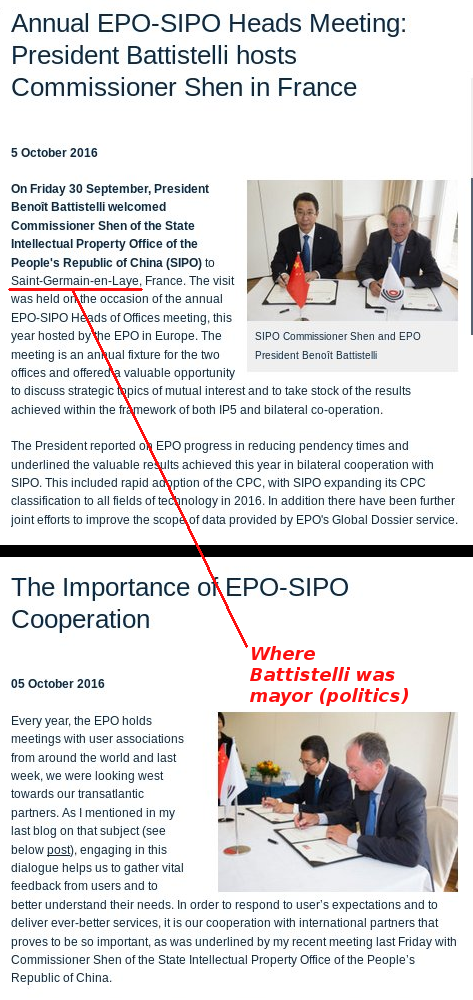
Summary: The trajectory of the EPO under Battistelli’s leadership gives cause for very serious concerns, which include patent trolling and a humongous disservice to existing grantees of EPs (European Patents)
THE EPO may be going down the road of both China's SIPO and France's INPI (where Battistelli and many of his cronies at today's EPO top-level management came from). The Chinese have remarkably low patent quality (quantity over quality is the mantra) and the French, who fail to attract applications (French is spoken by far fewer people than Mandarin speakers), hardly care about quality at all. A French INPI clerk just rubberstamps (or simply files/shelves) everything that comes in. If the EPO follows the French model, then no examiners will be needed, just clerks who can follow a simple manual. How would one feel about one’s old/er EP/s if every crappy application on the EPO’s pile was suddenly granted or at least given hasty consideration for the sake of so-called ‘production’? Battistelli’s policy poisons the well or muddies the water right now. It is unfair to people who spent a fortune (and many years) pursuing EPs.
“If the EPO follows the French model, then no examiners will be needed, just clerks who can follow a simple manual.”As we noted here several weeks ago, east Asia is becoming attractive to patent trolls [1, 2], due in part to low patent quality (same as was the case in the US). There are more trolls and litigation, not just poor patent quality; there’s a correlation between those two things. SIPO is by far the worst in that regard. Korea and Japan, in the mean time, recognise the self-destructive nature of M.A.D. with patents, based on another article from IAM that says: “This blog has noted that one of the big themes in Asia’s automaking industry this year has been a significant move by Japanese and Korean brands to join defensive patent alliances. It’s a strategic shift for the industry that in many ways is being led by companies in this part of the world, rather than their North American and European counterparts. But Chinese companies have not yet followed the same path in significant numbers, and industry observers say with litigation on the rise there, buy-in from players in China will be crucial for these alliances going forward.”
One or two of IAM’s paid (partly by patent trolls) writers have focused a lot on Asia recently. See the latest issue’s “Patents in Asia 2016″ series, including focus on China, Japan, South Korea, and Malaysia. The feature item was actually about China, titled “Putting China’s patent rise into context” (all behind a paywall) and Jacob later wrote (partly in relation to this) that China welcomes crappy patent applications from the US, just like the EPO under Battistelli does. He recently started following me in Twitter (maybe out of curiosity, I find him a lot more balanced than Mr. Lloyd and Mr. Wild) and he didn’t put it in these words but instead he wrote:
It was eye-opening, but not necessarily shocking, to read on this blog last Tuesday the suggestion that Huawei’s mobile patents might generate up to 20% of all the patent income earned by Chinese companies. The conjecture appeared in a new research paper which seeks to revise (downward) earlier estimates of the total royalty stack on the typical mobile phone. The study looked at 49 major mobile licensors, of which Huawei was one of only two Asian operating companies (the other being Samsung Electronics).
Credit the Shenzhen-based company for building an IP team that has put it head and shoulders above its domestic competitors in terms of patent portfolio strength. I was reminded, though, of a quote by Huawei head of IP Jason Ding that appears in the issue of IAM out this week…
There is also an article about Foxconn.
Asian companies haven’t much to gain from a crappy patent system. Take Samsung for example. The most stupid patent that has made headlines in recent years (slide-to-unlock, hardly a novel concept at all) might soon cost Samsung more than $0.1 billion, based on reports like this new one and some remarks from Florian Müller (he wrote a lot more about it in Twitter). To quote Bloomberg (cited by Slashdot):
Apple Inc. won an appeals court ruling that reinstates a patent-infringement verdict it won against Samsung Electronics Co., including for its slide-to-unlock feature for smartphones and tablets.
In an 8-3 ruling, the U.S. Court of Appeals for the Federal Circuit said a three-judge panel was wrong to throw out the $119.6 million verdict in February. Instead, it ordered the trial judge to consider whether the judgment should be increased based on any intentional infringement by Samsung.
Does this not demonstrate how foolish software patents harm companies like Samsung, whose home country (Korea) does not permit software patenting (we wrote about this earlier in the month)? This new IAM article remarks on patent tax when it comes to phones, which makes them very expensive (“licensing return from mobile market at $14.3 billion”).
As for the patent system in France, where does one even begin? The patent system in France is worse than a bloody joke; one might even call it a facility for corruption in light of details about the Patent Boxes (we wrote about this too, several times in the recent past alone). Here is a new article about it, demonstrating that journalists have begun catching up with the dirty scheme:
France’s patent box legislation, which permits a 15 percent corporate tax rate for profits from licensing of intellectual property rights rather than the usual 35 percent corporate tax rate, is being challenged as unfair to the European Union single market.
The matter has come before the EU Code of Conduct Group for Business Taxation, where several EU countries—including Ireland, Bulgaria and the Baltic nations— are insisting the French patent box regime should be considered harmful.
Among those contesting France’s IP rate are EU member countries that were themselves previously criticized by France over their overall low corporate tax rates.
“The issue has surfaced because France insists its regime doesn’t need to be reformed as all EU member states agreed to do in 2014,” a European Union diplomat, who participates in the Code of Conduct Group of Business Taxation, told Bloomberg BNA Sept. 30.
“However, all other EU countries are reforming their tax regime and insist France must do the same. Some of these countries, many of them resentful over French criticism of tax dumping, are rejecting the French arguments against reform.”
In this new IAM article a connection between the French and the Chinese is highlighted, in the form of “France Brevets”:
Unlike IP Bridge and Intellectual Discovery, France Brevets did not provide comment for the feature, but anecdotal accounts suggest that there has been something of a shift in strategic focus at the firm in recent months – and the call for change has come from the highest levels.
It appears that securing a return on its 100% public sector investment is now the fund’s primary objective, with its aims of boosting the domestic SME sector and kickstarting a local market in IP assets taking a back seat, at least for the time being. Simultaneously, some key personnel have come and gone; in June, founding CEO Jean-Charles Hourcade was replaced by Didier Patry, who was previously head of IP at Eaton Aerospace and before that led Hewlett-Packard’s IP transactions department from 2002 to 2014. Pascal Asselot, who had served as the fund’s director of development and licensing since its establishment, departed in the same month.
The USPTO, which finally tightens patent scope and goes after trolls (more on that in articles tonight and tomorrow), isn’t the world’s worst; some of the worst are probably SIPO and INPI and this is what the EPO is connecting to (several days ago Battistelli bragged about meeting SIPO officials in the town where he used to be a mayor, over in France that's not even an EPO host nation). █
Permalink
 Send this to a friend
Send this to a friend
Posted in Europe, Patents at 3:41 pm by Dr. Roy Schestowitz
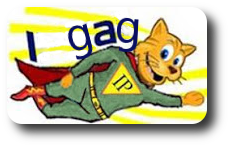
Summary: Suspicions that the popular blog IP Kat is suppressing criticism of the UPC are being aired, belatedly, over at IP Kat, hinting at the possibility of self-censorship due to financial motivations rather than fear of the EPO’s legal bullying, or strategic lawsuit against public participation (SLAPP)
THE EPO, as we last noted this afternoon, is trying to control not only media companies but also blogs, staff, and any other means of communication. The Office wants media blackout and information lockdown. Nobody but the chronic liar (Battistelli or cronies like Margot Fröhlinger) is allowed to have a voice. AMBA, for example, is too afraid/reluctant to even respond to E-mails from Managing IP. This is basically the current strategy of the EPO and in a sense it’s both clever and effective. That’s why North Korea and Iran adopted it.
Remember the times when IP Kat was a go-to place and a critical voice regarding the EPO? That was quite a while back. They write nothing about the subject anymore, so I asked them about it online. I am still waiting for an answer.
Several interesting (but old) comments were published at IP Kat shortly after we had noted something about IP Kat not publishing particular comments (we wrote about it in the afternoon), though the timing is quite possibly a coincidence, so we’re not suggesting that they did this in response to something we had written.
Here is what one comment asked: “Dear team of IPkat, I haven’t seen a post about the situation at the EPO since a couple of months. How come? Do you think there are no news? Have you been threatened? 3 staff rep in The Hague are being under investigation at the moment. Staff is planning demo next week. How come you do not report about it?”
No response since. I too asked them and have not received a response. “Has IP Kat been threatened — not just censored — by the EPO,” I asked IP Kat and its founder. “Given the circumstances, no reply might be “yes”,” I added.
Remember that IP Kat already received threats from other such bodies, as did a few other bloggers (not even big publishers and paid journalists).
Nowadays it feels like IP Kat writers, not wanting to have particular things mentioned, simply suppress particular things (censorship and also self-censorship). Some believe it’s done for fear that the EPO would censor them again (or maybe even send threatening letters as they did to me). Some bloggers did humorously insinuate that IP Kat was next on the EPO’s naughty list. First they were added to the censorship list (after they had done this to me), so is a threat of lawsuit next in line? Just the thought itself would be enough to gag (self-censor) IP Kat. It’s known as the Chilling Effect and next week — not fearing retaliation — we shall write about the chinchilla effect.
Here is a comment about alleged criminals at the top of the EPO. The EPO simply chooses call those who mention charges against them “defamation”. Here is the comment which is days old and IP Kat has not published until a relatively short while ago (I see publication time through my RSS feeds):
To further reinforce the narrative about defamation, VP3 sued the member of the board of appeal for in a German court – you may have read the outcome above (28/09): it appears that the Procurator dismissed the case recently.
Actually it was VP4 who tried to file a lawsuit in Germany.
His litigation track record is not so hot.
In January 2015 he apparently lost a defamation lawsuit in his home country:
http://techrights.org/2015/03/18/full-judgment-against-topic/
Now it seems that the German Procurator didn’t even consider it worthwhile opening proceedings against the person accused of defamation.
But don’t worry he still enjoys the favour of the Lord Protector of Eponia.
“Well,” the person later added. “my last comment about VP4 seems to have been suppressed.”
This comment too was suppressed (no way it was detected/identified as spam), so it looks like IP Kat hoped nobody would notice what had happened. I was already told, since almost a year ago by multiple people, that IP Kat had been deleting (not publishing is the equivalent of that) their comments. They deleted mine too. See this example and also this one (later they blamed the latter on spam filtering, but the former they just simply deleted).
For IP Kat to suppress discussions about EPO’s scandals is a lot easier these days; now the blog just no longer writes anything on the topic (hence every comment would be off topic); the only comments about it (if published at all) are clustered in some very distant page from 4 months ago. “I think it is still possible to post,” one person wrote, but there’s no guarantee that what gets posted will in fact be published. Well, maybe it depends on what it’s about. Selective publication of comments is a form of censorship, by definition (I have been reading and writing about the subject of censorship for several years, so I am very familiar with the methods).
One person asked “Has the thread reached its limit” and “It seems so” was the response, until IP Kat suddenly published half a dozen comments in this thread alone (in the mean time it did publish numerous other comments, every day in fact, so being absent from moderation is not a valid excuse).
Please note, based on the above, that there are no offensive words in there or anything that should invoke a spam filter (potential excuse in these cases). There are no clickable links, either.
Another new comment, this one regarding the UPC which the blog habitually promotes/markets, says the site “seems to be so highly unwilling to put information like this in the public domain” because it’s against the UPC. The thread touches on (promotes) the UPC, so the comment is relevant, it’s definitely on topic, and it refutes the original propaganda from the Bristows employee by stating:
This is my second attempt to get this comment posted, after the first one made on 10/06/16 at around 11:30 a.m. CEST still remains to be published, despite its receipt having been confirmed.
To the commentators on 10/04/16, 21:13 and on 10/05/16, 8:30:
Don´t forget to mention Mr Haft who is also a member of said committee of the German Bar Association. His firm Hoyng ROKH Monegier was created just recently by a Dutch and a German firm joining forces in joyful anticipation of the UPC. Should the UPC now not become a reality, this may well consitute a delicate situation for them… It is vested interests like these that bring about desperate suggestions such as going ahead with the UPC at any cost and even without a crucial participant like the UK.
It is left to the imagination of the readers why the IPKat (and more specifically the author of this post) seems to be so highly unwilling to put information like this in the public domain, apparently going so far as to even censor respective comments.
These conflicts of interest in the collusion behind UPC 'experts' were previously noted in relation to Tilmann, whom we mentioned here before in [1, 2, 3, 4, 5]. This seems to suggest that the IP Kat blog not only censors criticism of the EPO but not also expands its suppression of comments to the UPC (although evidence is too scarce at this stage).
If IP Kat deleted (or did not publish) your comment/s, please get in touch with us so that we’ll know how broad the problem has become. If we are seeing selective coverage of particular sides depending on one’s agenda/goals/objectives/profit motive, then it is more severe than censorship and self-censorship for fear of SLAPP from the EPO.
For the record, Techrights accepted each and every one of the 33,583 comments posted over the years (zero censorship), including extremely rude and racist comments. That is what free speech means. █
Permalink
 Send this to a friend
Send this to a friend
Posted in Europe, Patents at 9:56 am by Dr. Roy Schestowitz
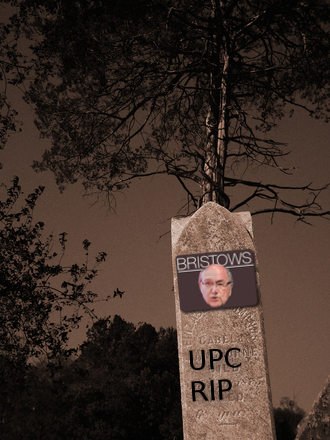
Summary: The endless lobbying and selfish aspirations of Team UPC are going nowhere but the grave, albeit the scope of patents at the EPO (related to litigiousness and spurious/frivolous lawsuits) is still a cause for concern, especially now that Battistelli turns the EPO into another SIPO or INPI (rubberstamping operation with no effective controls)
THE UPC is in complete and utter disarray. We hardly ever hear about the UPC anymore, especially since the (in)famous speech of the British Prime Minister. A few days ago we saw Bristows LLP/UPC, a key British component of Team UPC, saying that Richard Gordon’s opinion “provides limited comfort” (this was also mentioned in IP Kat, where a lot of the UPC boosters hang out these days)
“We hardly ever hear about the UPC anymore, especially since the (in)famous speech of the British Prime Minister.”Who is this of “limited comfort” to? Team UPC, surely. The back room schemers and liars don’t want to accept that the UPC is dead, if not only in the UK then in Europe as a whole. As Bristows reveals, it actually sponsored this ‘opinion’, so it’s about as legitimate as those 'studies' Battistelli will present this coming week. To quote Bristows (emphasis ours): “The opinion of Richard Gordon QC and Tom Pascoe (here) has been widely reported as providing reassurance that there are no legal difficulties in the way of the UK participating in the UPC post-Brexit. As one of the sponsors of the opinion, Bristows does not share this viewpoint. The opinion merely reaches its conclusions “on balance” and other views remain perfectly credible. Moreover, it is a purely legal analysis and does not, of course, comment upon the political realities of the requirements it sets forth. The opinion makes it very clear that several boxes would have to be ticked in order to maximise the chances of the CJEU deeming the system legal, which are more or less inconceivable in the present political climate, especially following the Prime Minister’s speech at the recent Conservative Party conference. At least in the short term there is virtually zero chance of the UK ratifying the UPC Agreement, and the real question arising is: what are the longer term prospects for salvaging the UPC project – with UK participation?”
“Bristows is also, unsurprisingly, lobbying for software patents and all things that patent trolls love. It’s all about patent and litigation scope. For them, the more the merrier.”Nothing. Forget about it. Deal with the fact that you advertised fake jobs that did not exist and probably will never exist. That’s how unethical the people of Bristows have become and this is why we don’t merely single them out; we just know who the enemy of a sane patent system is. Bristows just wants lots of lots of litigation; that’s what Bristows profits from. Don’t let them get their way as any litigation comes at the rather great expense of people who actually produce things or buy things. Bristows is also, unsurprisingly, lobbying for software patents and all things that patent trolls love. It’s all about patent and litigation scope. For them, the more the merrier.
In other news, patents on genetics have taken a massive blow because according to this new report:
The 9-month-old patent battle over CRISPR, a novel genome-editing tool that could have immense commercial value, has taken two surprising twists.
[...]
In last week’s filing, attorneys for the Broad Institute asked patent officials to remove two of its issued patents that focus on saCas9 from the original case, as well as two other patents (and a few affiliated claims in other patents) that describe techniques for enabling the CRISPR-Cas9 construct to target the nucleus of a eukaryotic cell.
Patents on life, along with patents on algorithms, are extremely controversial. For good reasons, too. Both appear to be on their decline/demise in the US right now (if not globally). Companies know this. Recall Mayo.
“Patents on life, along with patents on algorithms, are extremely controversial. For good reasons, too.”Meanwhile, regarding the EPO Hepatitis C patent/s which we mentioned here the other day (expectation of decision noted a week earlier), there are more articles about the subject [1, 2, 3, 4] and to quote one of them: “Following the development from the EPO, MdM already claims that “the EPO’s decision means that sofosbuvir in itself is not protected by a patent any more.” However, Gilead was quick to refute the claim. STAT news quotes a Gilead spokesman’s statement which maintained the patent.”
There are various groups that combat patent maximalism in medicine. One of them the opportunists in the EPO now try to associate with for cheap PR stunts. “To support #MedsPaL,” the EPO wrote, “we are working in close collaboration with @inapichile, @EPOorg & @OnapiRD.”
Fro those who don’t know what MedsPaL is, see this new article from IP Watch. To quote:
A new database was launched this week to facilitate navigation through the patent field and increase transparency surrounding the patent status of medicines and licences.
The Medicines Patent Pool (MPP), Chile’s National Institute of Industrial Property (INAPI), and global health initiative UNITAID held a side event at the WIPO General Assemblies on 5 October. The event was held to present “MedsPaL”, the MPP’s Medicines Patent and Licenses Database, discuss the difficulties in navigating the patent field, and report on the activities by regional and national patent offices, which could inform and build on the new database.
Why would MedsPaL wish to be associated in any way with the EPO, where abuses against people are so frequent and cancer patients are shamefully disliked? And speaking of association issues, Research and Markets seems to have taken an interest in the EPO [1, 2] and it plans to give seminars in London next month. To quote a portion from one of those two new press releases:
The problem/solution’ approach is not officially part of the EPC, but is a criterion which has been developed by case law. It is now is hard to find a decision of the Boards of Appeal which do not rely on the problem/solution approach in order to decide upon inventive step. It looks easy, but when applied, it should be applied correctly. This is not just a formal matter, but a substantial issue of first importance.
One thing that Research and Markets overlooks is that today’s EPO violates the EPC on a regular basis, e.g. [1, 2]. It also attacks the Boards of Appeal (see, e.g., [1, 2, 3, 4]), the body/apparatus that’s supposed to ensure high patent quality at the EPO and can no longer properly do its job because of understaffing, lack of independence etc. — especially now that Battistelli puts a mortal end to patent quality at the Office (necessitating these boards the most). █
Permalink
 Send this to a friend
Send this to a friend
Posted in Deception, Europe, Patents at 8:59 am by Dr. Roy Schestowitz
…Not to mention lies about performance [1, 2]
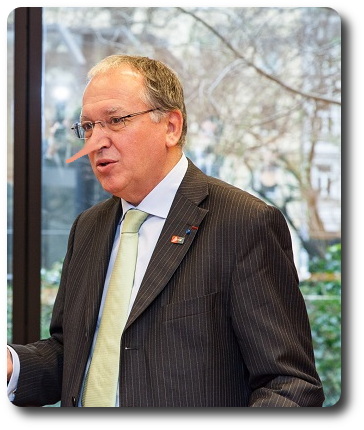
Source (original): Rospatent
Summary: Battistelli’s house of cards, or the empire/castle of lies, continues to build up ahead of the upcoming “Social Conference”, which is little more than a union-busting enabler and tranquiliser for the delegates of the Administrative Council
Jesper Kongstad, the Chairman of the Administrative Council (AC), could save staff representatives at the EPO but chose not to. It’s part of a pattern of indifference from the Administrative Council towards EPO staff and protectionism for Team Battistelli. One begins to wonder if the Administrative Council has been so thoroughly infiltrated or incentivised to basically stop doing its job and practically become just an extension — not a supervisor — of the Office.
A couple of days ago, writing in the IP Kat blog that no longer covers EPO scandals, one comment said: “It doesn’t seem to be possible to post further comments. Has the thread reached its limit ?”
No comment since. We don’t know why (maybe a manual ending to a discussion).
“One begins to wonder if the Administrative Council has been so thoroughly infiltrated or incentivised to basically stop doing its job and practically become just an extension — not a supervisor — of the Office.”EPO staff has been losing its voice since the EPO bullied some publications like ours (including the infamous ban on IP Kat) and paid a lot of money to control the rest. The EPO did all this whilst attacking the EPO unions, which also constitute the staff’s voice. The European Patent Office, which is unaccountable, is now a totally rogue institution without effective controls (either inside or outside). It’s even worse than WIPO, where Gurry just got away with everything (stories about this subject can be found in our daily links since Friday). Based on this tweet, Battistelli’s lobbying event (charade) that costs millions of Euros will carry on. Who’s to say no? Who can even say no? Now that Battistelli is wasting millions of Euros on bogus ‘studies’ will the Administrative Council hold him accountable? Will anyone ever treat Battistelli as anything other than some kind of monarch? The EPC that establishes the status quo was supposed to ensure this would not happen, but right now the EPO is pretending to care for the EPC — all this while it violates the EPC on a regular basis, e.g. [1, 2].
“EPO staff has been losing its voice since the EPO bullied some publications like ours (including the infamous ban on IP Kat) and paid a lot of money to control the rest.”Next week there is a major propaganda campaign from Battistelli. The target audience is the Administrative Council and Battistelli’s lapdog (or pet chinchilla), Jesper Kongstad. We don’t expect too see any dissent in the campaign’s event because staff representatives have already been intentionally blocked from entering (we wrote a couple of articles about this before). The Local Staff Committee at The Hague met about a week ago and plans to demonstrate in a few days. "Social Conference" nonsense from Battistelli surely and understandably irritates those whom it will lie about (in their absence).
“Meanwhile,” one person wrote, “the President is trying to sew together fig leaves, and has called for a “Social Conference”. [...] The SUEPO Committee hopes and counts on staff to provide a clear and solid mandate – one that can be reasonably expected to terminate the abuses of the present management and restore (inter alia) the union rights at the EPO.”
“”Social Conference” nonsense from Battistelli surely and understandably irritates those whom it will lie about (in their absence).”Protests in Munich will start in just two days. We reckon that a lot of it will fall on Jesper Kongstad’s deaf ears, but hopefully politicians and the media will continue to press for justice. The EPO is spending over a million Euros per year controlling the media through FTI Consulting and additional money is spent paying the media directly for puff pieces, so the latter (media) might have priorities other than to cover protests. Media blackout won’t affect Techrights and in fact I took two day off work next week, to enable me to cover what goes on in Munich and The Hague (please get in touch with us regarding any updates before, throughout, and after). █
Permalink
 Send this to a friend
Send this to a friend
Posted in Europe, Intellectual Monopoly at 7:41 am by Dr. Roy Schestowitz
 Summary: A closer look at the “FJORDBLINK” trademark and what happened to the entity which registered it in Denmark (where the Chairman of the Administrative Council of the European Patent Organisation is still in charge)
Summary: A closer look at the “FJORDBLINK” trademark and what happened to the entity which registered it in Denmark (where the Chairman of the Administrative Council of the European Patent Organisation is still in charge)
IN OUR fourth part of the series we wrote about a company connected to the Chairman of the Administrative Council of the European Patent Organisation (EPO), but there’s a side story that merits a mention at least in the addenda.
We managed to find a copy of a product brochure for the birth pool marketed by FJORDBLINK MEDICAL ApS [PDF]. The product brochure is dated May 2015.
“According to official CVR records this company ceased trading on 10 October 2013. It is unclear what has exactly has happened to the “FJORDBLINK” trademark registered by FJORDBLINK MEDICAL P/S or who, if anybody, is the current assignee.”There is a small mystery here that we have been unable to solve so far. The brochure refers to the name “FJORDBLINK” as a registered trademark. According to our research, the trademark is indeed registered both in Denmark and also as a European trademark [PDF] with the EUIPO in Alicante [PDF]. In Denmark it is registered under the number VR 2011 02145.
As a European trademark it is registered under the EU Trademark number 011266764. However, as we noted in a previous article the trademark was not registered by FJORDBLINK MEDICAL ApS (CVR number 25942507) but by another entity with a confusingly similar name: FJORDBLINK MEDICAL P/S (CVR number 33392737).
The CVR number 33392737 leads to a defunct limited partnership company by the name of FOME P/S with an address at Vibelandsvej 8, Valby, 3200 Helsinge. Between 31 December 2010 and 11 April 2013 the company operated under the name FJORDBLINK MEDICAL P/S and its registered address was in Randers where Helle Jahn Jørgensen resides.
According to official CVR records this company ceased trading on 10 October 2013. It is unclear what has exactly has happened to the “FJORDBLINK” trademark registered by FJORDBLINK MEDICAL P/S or who, if anybody, is the current assignee.
If anyone wishes to help us find out, please get in contact. █
Permalink
 Send this to a friend
Send this to a friend
Posted in Europe, Patents at 7:18 am by Dr. Roy Schestowitz
Summary: Some more views of the Bremelandsgård farmstead, courtesy of Google Maps, demonstrating overlap between FJORDBLINK MEDICAL ApS and Jesper Kongstad’s residence
IN OUR previous post we wrote about a company connected to the Chairman of the Administrative Council of the European Patent Organisation (EPO) and explained why it’s of interest to us. This post contains additional information and observations including images.
If one types in the following company names into the search facility on Google Maps it recognises them and locates the company at the Bremelandsgård farmstead:
- Bremelandsgård v/Jesper Kongstad (the fur farming sole proprietorship) — to be covered in part 5 of our series
- FJORDBLINK MEDICAL ApS (the medical device company)
Google Maps was used to generate the following views of the farmstead, some with company tags (automatically provided by Google Maps) and some without.



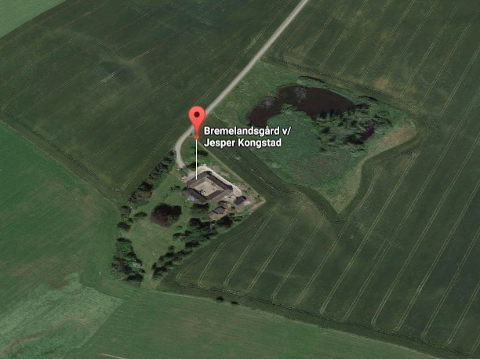
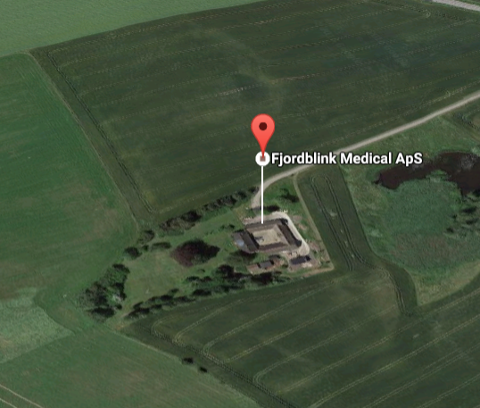
Part 5 will focus an another controversial aspect of the above farmhouse/mansion. It’s probably a lot more than just a house for ordinary people, akin to the mansion of Kim Dotcom in New Zealand. █
Permalink
 Send this to a friend
Send this to a friend
Posted in Europe, Patents at 6:55 am by Dr. Roy Schestowitz
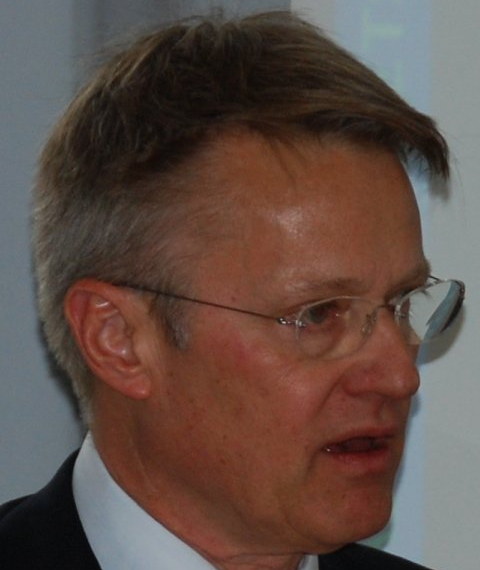
Photo credit: DKPTO at Flickr
Summary: The next installment of the Danish saga, this time dealing with the connections between Jesper Kongstad and a private company known as FJORDBLINK MEDICAL ApS
THE END of last week culminated in part 3 about the business ventures of Jesper Kongstad, Chairman of the Administrative Council of the European Patent Organisation (EPO). In the previous article we provided an overview of the Kongstad family business conglomerate which to seems to be mainly controlled via the holding company BREMELAND HOLDING ApS whose shareholders are Jesper and Majbritt Kongstad and their three sons.
“During the time when the Jørgensens were living in Horsens Ms. Jahn Jørgensen was active in local politics as a elected councilor for the Venstre party which forms the current minority government in Denmark.”In this contribution we will take a closer look at FJORDBLINK MEDICAL ApS (CVR number 25942507) which is a private limited company 100% owned by BREMELAND HOLDING Aps. The main business of FJORDBLINK is “to develop, produce, sell and trade with medical devices”.
It should be recalled that the registered address of both BREMELAND HOLDING ApS and FJORDBLINK MEDICAL ApS is Vibelandsvej 8, Valby, 3200 Helsinge which coincidentally corresponds to that of the current Kongstad family home “Bremelandsgård” (Danish for “Bremelands farm”).
“As far as can be determined, the original priority filing for protection was filed with the DKPTO on 19 November 2014.”The English language Web site of FJORDBLINK MEDICAL ApS can be found at en.fjordblink.com.
According to the FJORDBLINK Web site, the CEO and Administrative Director is Ms. Helle Jahn who according to the Danish Central Business Register (CVR) also goes by the name of Helle Jahn Jørgensen. Not a lot is known about Ms. Jahn Jørgensen apart from the fact that she used to operate a number of small businesses including a driving school and a trading company involved in “port-related activities” in the harbour town of Horsens on the eastern coast of Denmark’s Jutland peninsula. According to available information she is married to Michael Junk Jørgensen.
“The proprietor of the utility model is registered as FJORDBLINK MEDICAL ApS of Vibelandsvej 8, Valby, 3200 Helsinge. As noted above this corresponds to the address of the current Kongstad family home.”From the CVR it appears that Michael Jørgensen is a director of TELKO DENMARK A/S which is a wholly owned subsidiary of TELKO OY a Helsinki-based company (Finland) which according to its Web site, Telko.com, is “a distributor of chemicals and polymers with local offices and warehouses in Nordic, Baltic Eastern European countries and Central Asia”.
During the time when the Jørgensens were living in Horsens Ms. Jahn Jørgensen was active in local politics as a elected councilor for the Venstre party which forms the current minority government in Denmark. As noted in an earlier article, the Minister in charge of the DKPTO is Troels Lund Poulsen, a prominent member of Venstre. It seems that the Jørgensens moved to Randers further north on the Jutland peninsula around 2013 or 2014 and it is not known if Ms. Jahn Jørgensen is still an active member of Venstre.
Returning now to FJORDBLINK MEDICAL ApS, according to information published on its Web site it has a wide-ranging network of distributors both in Europe (Germany, the Netherlands, Belgium, Italy, Portugal, Bulgaria, Greece, and Romania) and globally (China, India and Iran).
“Helle Jahn Jørgensen, the CEO of the company is named as the inventor.”Its main product is a device called the “Medical Birth Pool” which, according to its Web site was developed in collaboration with leading midwives at Danish hospitals for pain relieving water birth: “Fjordblink ® Medical’s product concept combines maximum comfort and safety for women in labor with professional requirements for functionality, ergonomics, and hygiene. Fjordblink ® Medical birth pools are therefore developed as a medical device and FJORDBLINK Medical is certified in accordance with the DS/EN ISO 13485 ISO standard.”
An interesting detail concerning the “Medical Birth Pool” is that intellectual property rights protection has been secured for it in the form of a so-called “utility model” which is also known as a “Gebrauchsmuster” in Germany.
As far as can be determined, the original priority filing for protection was filed with the DKPTO on 19 November 2014. The publication number of the Danish Utility Model Publication (“Brugsmodelskrift”) is DK 2014 00163 U3.
“The previous company name STRANDHØJ HOLDING ApS is understood to refer to the previous Kongstad family…”The proprietor of the utility model is registered as FJORDBLINK MEDICAL ApS of Vibelandsvej 8, Valby, 3200 Helsinge. As noted above this corresponds to the address of the current Kongstad family home. Helle Jahn Jørgensen, the CEO of the company is named as the inventor.
The corresponding German “Gebrauchsmuster” has the publication number DE 20 2014 105 549 U1. In line with the company’s global marketing ambitions the utility model protection has also been registered in China under the publication number CN 204337017 U [PDF].
According to data in the CVR, FJORDBLINK MEDICAL ApS was originally founded on 1 March 2001. From 28 December 2001 until 6 July 2006 it appears to have operated under the name KONGSTAD HOLDING ApS and from 7 July 2006 until 11 April 2013 under the name STRANDHØJ HOLDING ApS. The name FJORDBLINK MEDICAL ApS was adopted in 2013.
“Prior to 2013 it seems that Majbritt Kongstad acted as CEO and that Jesper Kongstad was the Chairperson of the Board of Directors.”The previous company name STRANDHØJ HOLDING ApS is understood to refer to the previous Kongstad family residence “Strandhøj” located at Højagervej 6, 2960 Rungsted (Google Street View).
Prior to 2013 it seems that Majbritt Kongstad acted as CEO and that Jesper Kongstad was the Chairperson of the Board of Directors. The annual accounts for the company for the period 01.01.2011 – 31.12.2011 when it was operating under the name STRANDHØJ HOLDING ApS were signed off by Jesper Kongstad on 31 May 2012. Details are in this PDF.
“In fact, during the years 2011 to 2015 significant losses were continuously registered.”In April 2013 the company underwent some internal restructuring. Majbritt Kongstad resigned her position as CEO and was replaced in this role by Helle Jahn Jørgensen. At the same time Ms. Kongstad was appointed as Chair of the Board of Directors. The other member of the Board of Directors is a Danish lawyer Ernst Ulrik Bayer who is associated with the prominent Copenhagen law firm Molke Leth.
A perusal of the company’s financial statements also reveals some interesting information. It seems that the company has not been a commercial success so far. In fact, during the years 2011 to 2015 significant losses were continuously registered. Based on CVR figures, the operating result for 2015 was a deficit of 2,412,563 DKK (approx – 323,400 EUR). In 2014 the deficit was 1,447,343 DKK (approx. – 194.014 EUR). The operating losses for the years 2013, 2012 and 2011 were respectively 928.393 DKK (approx. – 124.449 EUR), -3,842,877 DKK (approx. – 515.131 EUR) and 109.388 DKR (approx. – 14.663 EUR).
“The certificate of registration is dated 14 September 2011 and signed by the Director General of the DKPTO, Mr. Jesper Kongstad.”The annual report for 2015 contains a statement to the effect that the company has used important resources on development and quality assurance, and that 2016 again is expected to generate an operating loss (due to product development, documentation, quality assurance and marketing) while 2017 should yield an operating profit. BREMELAND HOLDING Aps, the owner of the company and the main holding company of the Kongstad family conglomerate is named as the guarantor for the deficit in 2016 while an unidentified third party has apparently given a guarantee for the company’s liabilities. See this PDF.
A further interesting detail in this saga concerns the registration of the name “FJORDBLINK” as a trademark in the Danish Register of Trade Marks under the number VR 2011 02145.
The official DKPTO correspondence concerning the registration of the trademark can be found online here.
The certificate of registration is dated 14 September 2011 and signed by the Director General of the DKPTO, Mr. Jesper Kongstad. According to the certificate the registration is valid for a period of ten years. See this PDF.
“The trademark registration application on behalf of FJORDBLINK MEDICAL P/S was apparently filed by Ms. Helle Jahn (Jørgensen) who was subsequently appointed as CEO of FJORDBLINK MEDICAL ApS in 2013.”What is striking here is the fact that the application for the trademark registration was filed in the name of FJORDBLINK MEDICAL P/S (CVR number 33392737) rather than by FJORDBLINK MEDICAL ApS (CVR number 25942507). The trademark registration application on behalf of FJORDBLINK MEDICAL P/S was apparently filed by Ms. Helle Jahn (Jørgensen) who was subsequently appointed as CEO of FJORDBLINK MEDICAL ApS in 2013. PDF here.
The CVR number 33392737 leads to a defunct limited partnership company by the name of FOME P/S with an address at Vibelandsvej 8, Valby, 3200 Helsinge.
It appears that between 31 December 2010 and 11 April 2013 the company operated under the name FJORDBLINK MEDICAL P/S and that its registered address during that period was in Randers where Helle Jahn Jørgensen resides.
According to the CVR, Majbritt Kongstad was appointed as CEO of this company on 12 April 2013 and the address was changed to Vibelandsvej 8, Valby, 3200 Helsinge. At around the same time, the lawyer Ernst Ulrik Bayer and Asger Kongstad, apparently a son of Jesper and Majbritt Kongstad, were appointed to the Board of Directors.
“The case of FJORDBLINK MEDICAL seems to throw up a lot of unanswered questions about potential conflicts of interest and there are a number of as yet unsolved riddles about its operations.”Some time thereafter on 10 October 2013 the company appears to have ceased trading. In view of the dissolution of FJORDBLINK MEDICAL P/S is unclear what has happened to the “FJORDBLINK” trademark and who, if anybody is the current assignee.
The case of FJORDBLINK MEDICAL seems to throw up a lot of unanswered questions about potential conflicts of interest and there are a number of as yet unsolved riddles about its operations. Perhaps somebody will be able to carry out further investigation in order to clarify these matters.
In case of link erosion or critical material going offline we have decided to make local copies of some documents. Included are the following items:
- Copies of utility model certificates referred to in the text for China
[PDF], Germany [PDF], and Denmark [PDF].
- Copies of documents relating
[PDF] to the “FJORDLAND” trademark registration [PDF] (in Danish).
- Copy of “Strandhoj” annual accounts
[TIF] for 2011 signed off by Jesper Kongstad on 31 May 2012.
- One further interesting detail concerning FJORDBLINK MEDICAL ApS which has come to light is worth highlighting. The official correspondence relating to the utility model application in Denmark is available online via the DKPTO’s Web site. One of the documents submitted with the application is a power of attorney which is co-signed by Majbritt Kongstad and Helle Jahn (Jørgensen). A copy of the power of attorney is now on our server
[PDF], in order to assure/ensure it remains available/accessible to all.
Addendum/addenda, containing more visual items, will be published separately. █
Permalink
 Send this to a friend
Send this to a friend
« Previous entries Next Page » Next Page »






 Summary: A closer look at the “FJORDBLINK” trademark and what happened to the entity which registered it in Denmark (where the Chairman of the Administrative Council of the European Patent Organisation is still in charge)
Summary: A closer look at the “FJORDBLINK” trademark and what happened to the entity which registered it in Denmark (where the Chairman of the Administrative Council of the European Patent Organisation is still in charge)





















 Content is available under CC-BY-SA
Content is available under CC-BY-SA